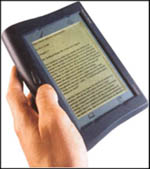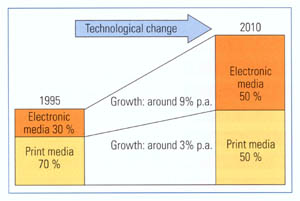|
|
Printed Media versus Electronic Media ?
Printed Media and Electronic Media in the Present
Production technologies for Printed Media enable high quality and economic production. Moreover, Printed media are particularly easy to use in many locations and almost every environment, without recourse to any special equipment. Nevertheless, the information content of print media is static/fixed and cannot be quickly changed interactively. In comparison, Electronic Media, which include the latest developments in the internet and World Wide Web, allow the integration of audio and video, which is speech, music and animations, into the information document along with text, graphics, and image information. This gives the user many ways of interacting with the information: it is possible to make selections and add components – the content is dynamic. Special equipment, however, is required for using electronic information. The transfer of information via electronic media creates a varied array of interesting and useful applications. Therefore, with the following example, electronic media provide innovative alternatives to print media.
The Rocket eBook (NuvoMedia), has a convincing, user friendly size. Its memory capability is sufficient to download extensive electronic books from networks or data storage machines (Kipphan 2001, p. 1114).
 ebook (Kipphan 2001)
ebook (Kipphan 2001)Printed Media and Electronic Media in the Future
Because of innovation and changes in technology, business and society, the demand for information via printed media and electronic media is clearly increasing world-wide. But, the ratio between the market shares of print media and electronic media is becoming more balanced. There is now a strong move towards electronic media, and long term predictions point to a 50:50 ratio between print media and electronic media.
 conclusion (Kipphan 2001)
conclusion (Kipphan 2001)However, it is appropriate to conclude with a few statements made in the past, which spoke against the spread of print:
- Around 1920: Radio will replace print
- Around 1950: TV will replace print
- Around 1980: The computer will replace print
- Around 1990: The Internet will replace print
As we know today, these predictions soon turned out to be glaringly incorrect. Each of these statements was based on a fascination with new technologies, which eventually led to speculative, one-sided predictions that new media would replace the old.
